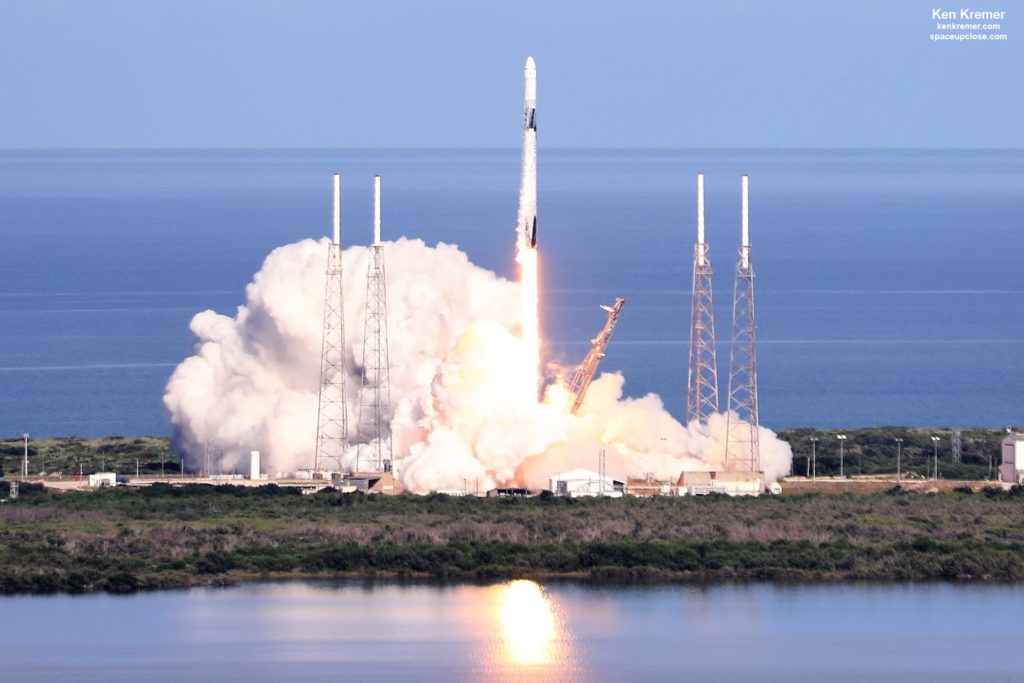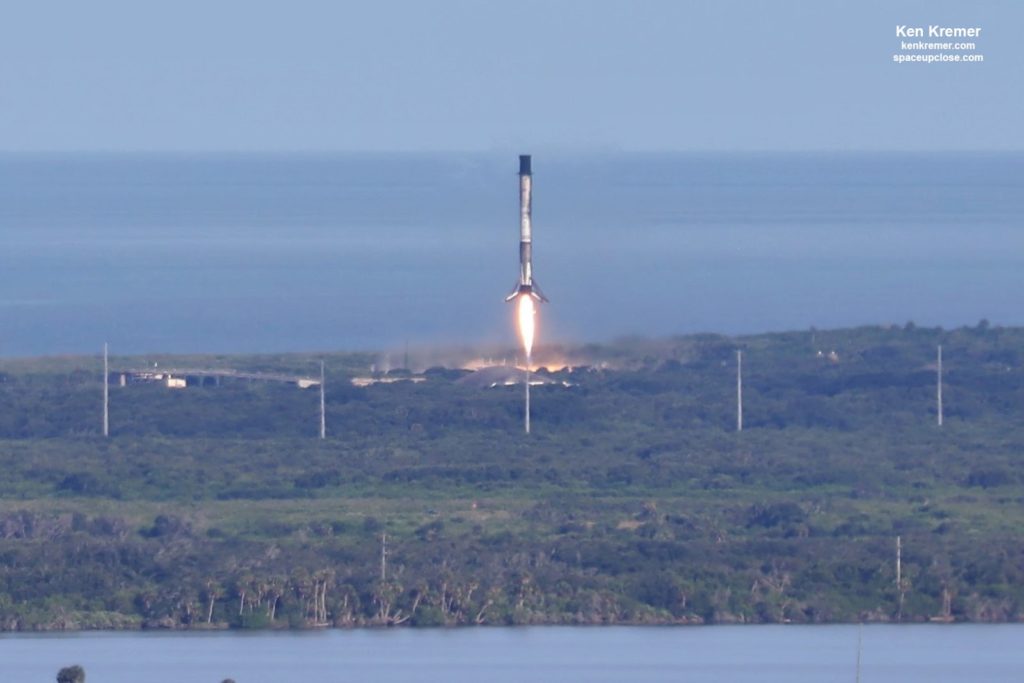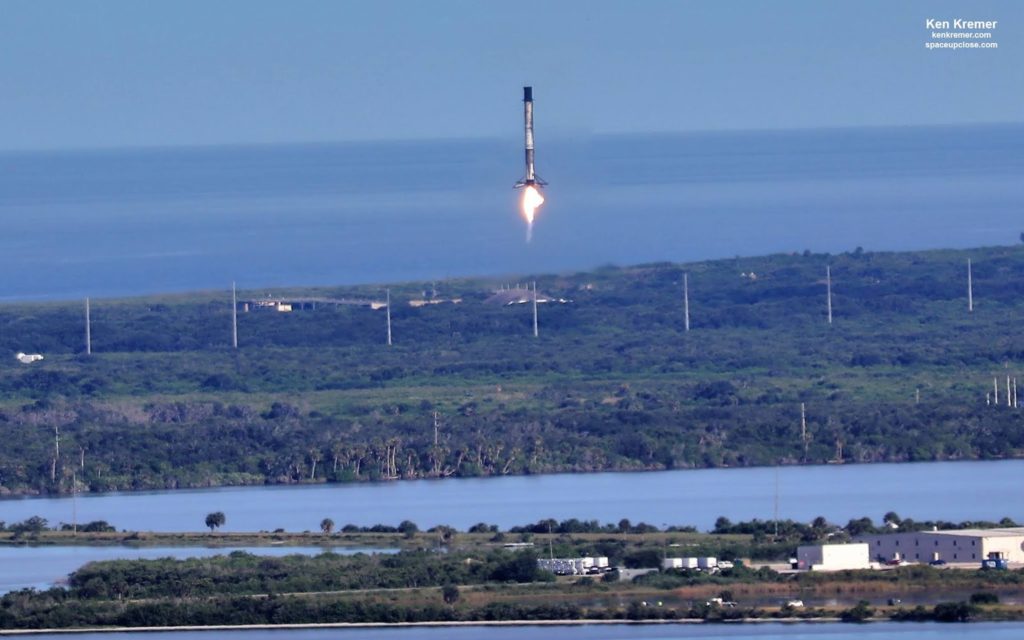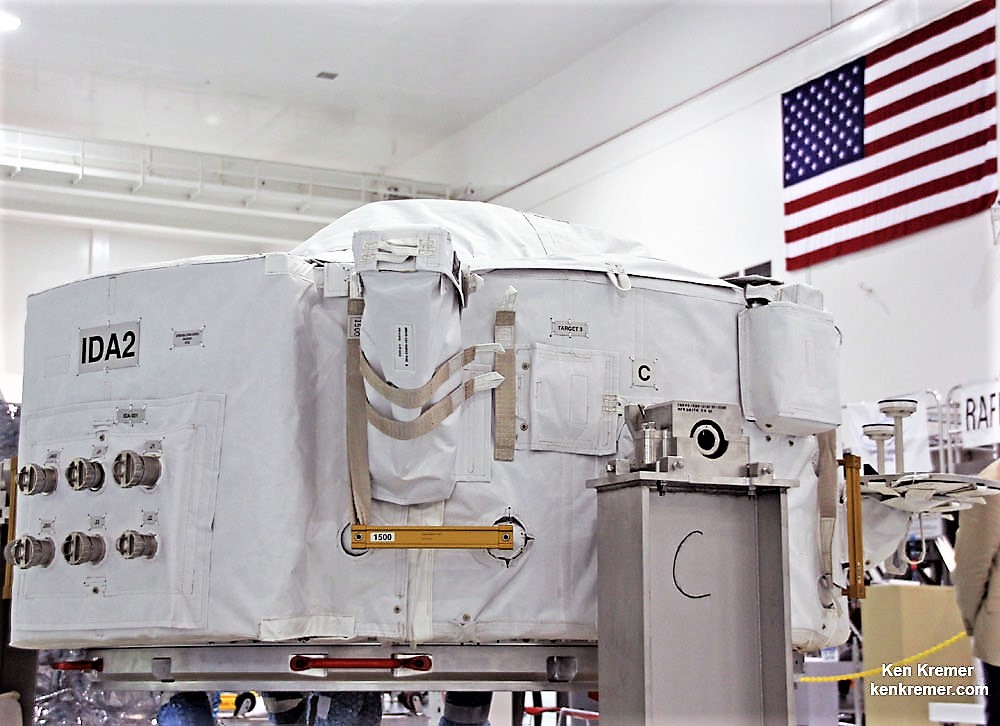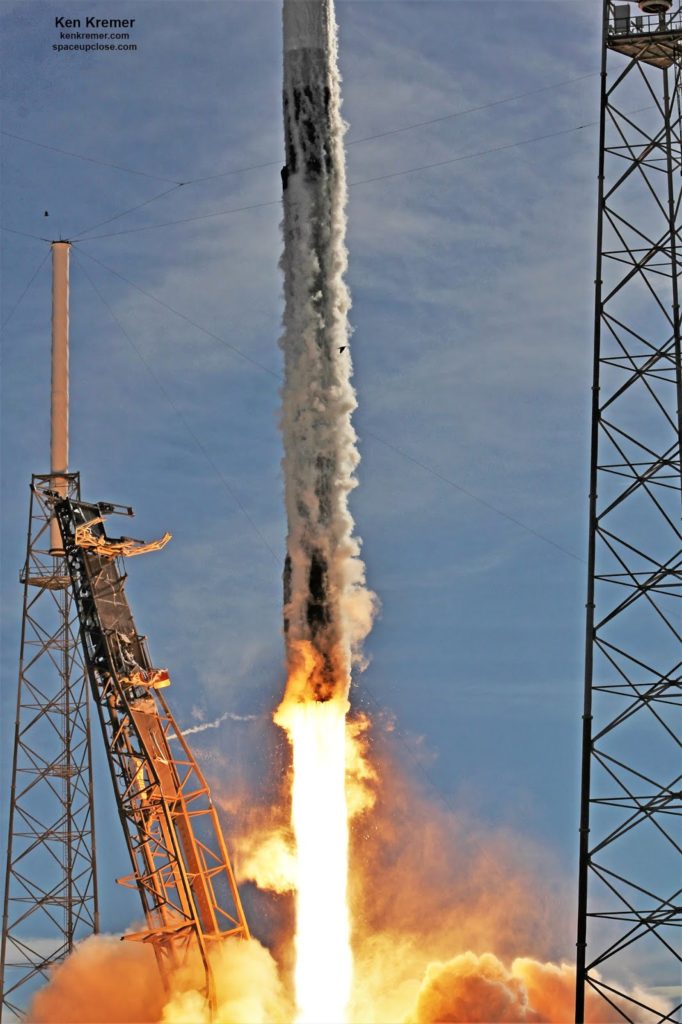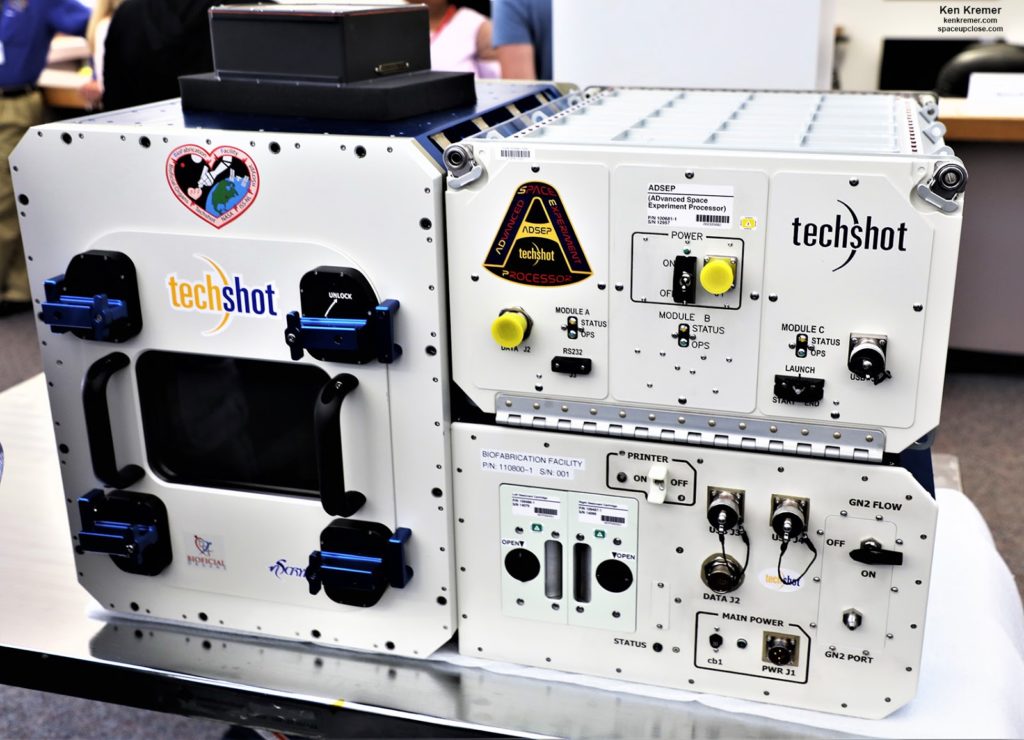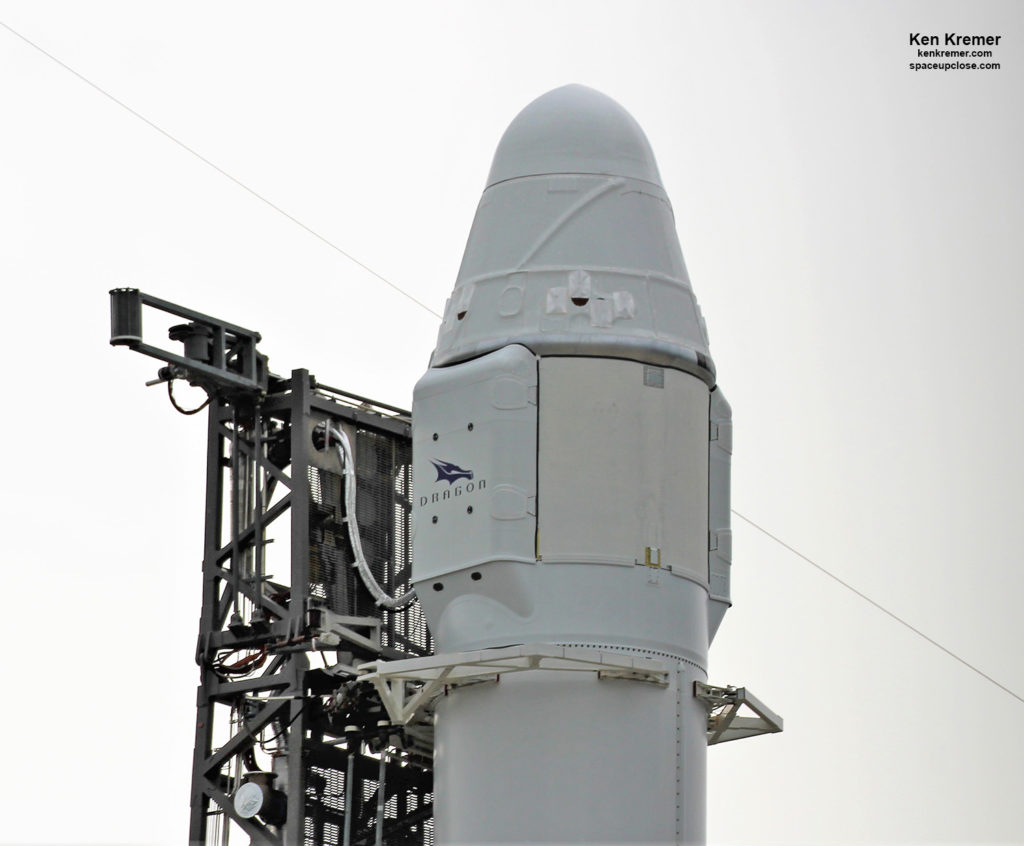Ken
Kremer — SpaceUpClose.com &
RocketSTEM – 25 July 2019
KENNEDY SPACE CENTER, FL – After
days of rain showers and threats of thunderstorms the skies over the Florida
Space Coast cleared in the final
moments of the countdown to liftoff in a near miraculous turn in the weather outlook and a used SpaceX Falcon 9 rocket blasted
off bound for the International Space Station (ISS) on a stunningly beautiful
launch with a new NASA docking port, a human tissue biofabrication experiment and two and a half tons of research gear
and supplies Thursday evening, July 25.
Eight minutes later the now
twice used booster safely touched down back at Cape Canaveral Air Force Station
to a crescendo of shockingly loud sonic
booms heard all across the central Florida region.
The recycled SpaceX Falcon 9 rocket successfully launched
from Cape Canaveral Air Force Station’s Space Launch Complex 40 in Florida on
July 25, 2019, at 6:01 p.m. EDT, carrying the company’s private Dragon spacecraft to
the International Space Station on its 18th
Commercial Resupply Services (CRS-18) mission.
“It was a great launch, we were really happy
to see the weather clear out the way it did,” said Bill Spetch, deputy manager
of the International Space Station Transportation Integration Office at NASA.
Check out our gallery
of Space UpClose eyewitness photos captured at the launch pad on Cape Canaveral
Air Force and the Kennedy Space Center – from the roof of the Vehicle Assembly
Building (VAB) and around the Launch Complex 39 Press Site.
Click back as the gallery grows.
Liftoff was delayed a day by awful Space Coast
weather when poor weather from anvil clouds, thunderstorms and lightning put
an end to hopes to launch of the SpaceX Falcon 9 on a cargo delivery run for NASA
to the International Space Station (ISS) as the countdown clock clicked relentlessly
down to T-Zero. A scrub was finally called as expected in the final moments
before the hoped for liftoff Wednesday evening July 24.
At last the now
twice used Falcon 9 first stage performed flawlessly and put on a magnificent 24
hour belated launch and landing show for the many tens of thousands and
thousands of spectators ringing the Space Coast region at dinnertime this
evening – culminating with multiple sonic booms.
As the 15
story tall first stage refired a subset of its its Merlin 1D engines the descending
booster decelerated from over 1000 MPH and passed through the sound barrier sending
our sonic booms in all directions that rattled houses, wall and fixtures in
nearby Titusville and Cape Canaveral and more.
 |
|
Credit: Ken Kremer/kenkremer.com/spaceupclose.com
|
The goal of the CRS-18 mission is cargo delivery
for NASA carrying over 5000 pounds (2300 KG) of science and supplies to the International Space Station (ISS) from the Florida Space Coast.
Among the cargo is a very important docking
adapter known as International Docking Adapter-3 (IDA-3),
which is required to be on station in order for the new commercial
crew spaceships from SpaceX and Boeing to dock to it at the orbiting outpost.
Also aboard is the Techshot 3D BioFabrication Facility (BFF) – the first ever 3D printer
capable of manufacturing human tissue in orbit.
1st experiments will focus
on printing human cardiac cells. This 500 lb unit was on display at the
KSC press site – see our photo below.
The CRS-18
mission features a once flown Falcon 9 Block 5 version rocket that launched in
May 2019 on the CRS-17 resupply mission -also from pad 40.
The Dragon is also recycled and marks the first time that
SpaceX will use a Dragon for the third time.
This Dragon CRS-18 Dragon cargo ship previously launched in
April 2015 on CRS-6 and December 2017 on CRS-13.
The two stage Falcon 9/Dragon rocket stands
about 213-feet (65-meters) tall.
Here are details from NASA about some of the
scientific investigations Dragon is delivering to the space station:
investigation will provide insight into the physical interactions of liquid,
rocks and microorganisms under microgravity conditions and improve the
efficiency and understanding of mining materials in space. Bio-mining
eventually could help explorers on the Moon or Mars acquire needed materials,
lessening the need to use precious resources from Earth and reducing the amount
of supplies that explorers must take with them.
human organs has long been a dream of scientists and doctors around the globe.
However, printing the tiny, complex structures found inside human organs, such
as capillary structures, has proven difficult to accomplish in Earth’s gravity.
To overcome this challenge, Techshot designed their BioFabrication
Facility to print organ-like tissues in microgravity – a stepping
stone in a long-term plan to manufacture whole human organs in space using
refined biological 3D printing techniques.
Improving Tire Manufacturing from Orbit
investigation will use microgravity to push the limits of silica fillers for
tire applications. A better understanding of silica morphology and the
relationship between silica structure and its properties could improve the
silica design process, silica rubber formulation and tire manufacturing and
performance. Such improvements could include increased fuel efficiency, which
would reduce transportation costs and help to protect Earth’s environment.
cells genetically programmed to return to an embryonic stem cell-like state –
have the ability to develop into any cell type in the human body, potentially
providing an unlimited source of human cells for therapeutic purposes. Space
Tango-Induced Pluripotent Stem Cells examines how specialized white
blood cells derived from iPSCs of patients with Parkinson’s disease and
multiple sclerosis grow and move in 3D cultures, and any changes in gene
expression that occur as a result of exposure to a microgravity environment.
Results could lead to the development of potential therapies.
compares mosses grown aboard the space station with those grown on Earth to
determine how microgravity affects its growth, development, and other
characteristics. Tiny plants without roots, mosses need only a small area for
growth, an advantage for their potential use in space and future bases on the
Moon or Mars. This investigation also could yield information that aids in
engineering other plants to grow better on the Moon and Mars, as well as on
Earth.
opportunities for U.S. government agencies, private industry, and academic and
research institutions to conduct microgravity research that leads to new
technologies, medical treatments, and products that improve life on Earth.
Conducting science aboard the orbiting laboratory will help us learn how to
keep astronauts healthy during long-duration space travel and demonstrate
technologies for future human and robotic exploration beyond low-Earth orbit to
the Moon and Mars.
….
After 2 days of carefully choreographed thruster
firings and orbit raising maneuvers Dragon
is scheduled to arrive at the orbiting outpost Saturday morning, July 27.
Live coverage of the spacecraft’s approach and
arrival will begin at 8:30 a.m. on NASA Television and the agency’s website.
Dragon will join three other spacecraft
currently at the space station.
Expedition 60
Flight Engineers Nick Hague
and Christina Koch
of NASA will use the station’s robotic arm, Canadarm2, to grab, or grapple,
Dragon around 10 a.m. Coverage of robotic installation to the Earth-facing port
of the Harmony module will begin at 12 p.m.
Dragon will remain berthed for about a month
before returning for a parachute assisted splashdown in the Pacific Ocean.
at Fox 35 TV News at the 2nd video of this link:
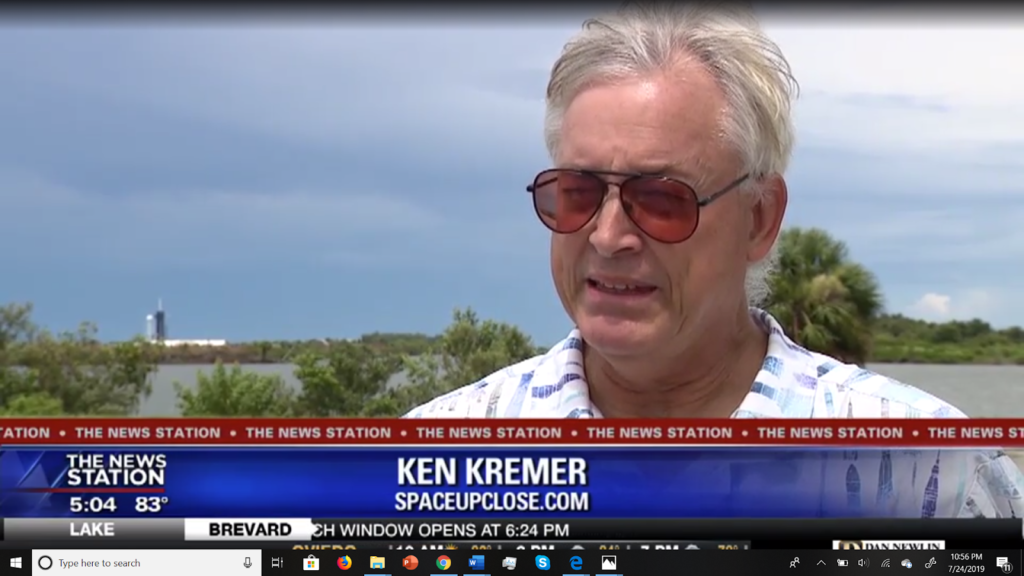 |
|
Dr. Ken Kremer/Space UpClose July 24, 2019 interview with Fox
35 Orlando TV News about the SpaceX CRS-18 mission to the ISS |
onsite at the Kennedy Space Center and Cape Canaveral Air Force Station for
live reporting of the SpaceX CRS-18 mission launch.
Watch for Ken’s
continuing onsite coverage of NASA, SpaceX, ULA, Boeing, Lockheed Martin,
Northrop Grumman and more space and mission reports direct from the Kennedy
Space Center, Cape Canaveral Air Force Station, Florida and Wallops Flight
Facility, Virginia.
Stay tuned here for
Ken’s continuing Earth and Planetary science and human spaceflight news: www.kenkremer.com –www.spaceupclose.com – twitter
@ken_kremer – email: ken at kenkremer.com
Dr. Kremer is a research scientist and journalist based in the
KSC area, active in outreach and interviewed regularly on TV and radio about
space topics.
………….
Ken’s photos are for sale and he is available for lectures and outreach events
Ken’s upcoming outreach events:
Jul 26: Quality Inn Kennedy Space Center, Titusville, FL, evenings. Learn more about the upcoming/recent
NASA Orion Ascent-2 Abort test Falcon Heavy, NASA 2024 Moon landing
goal, SpaceX Starlink-1, SpaceX Falcon 9/CRS-17
launch to ISS, SpaceX Demo-1 launch/test failure, SpaceX Beresheet launch, NASA missions, ULA Atlas & Delta launches,
Northrop Grumman Antares, SpySats and more
Ken will display his photos for sale


